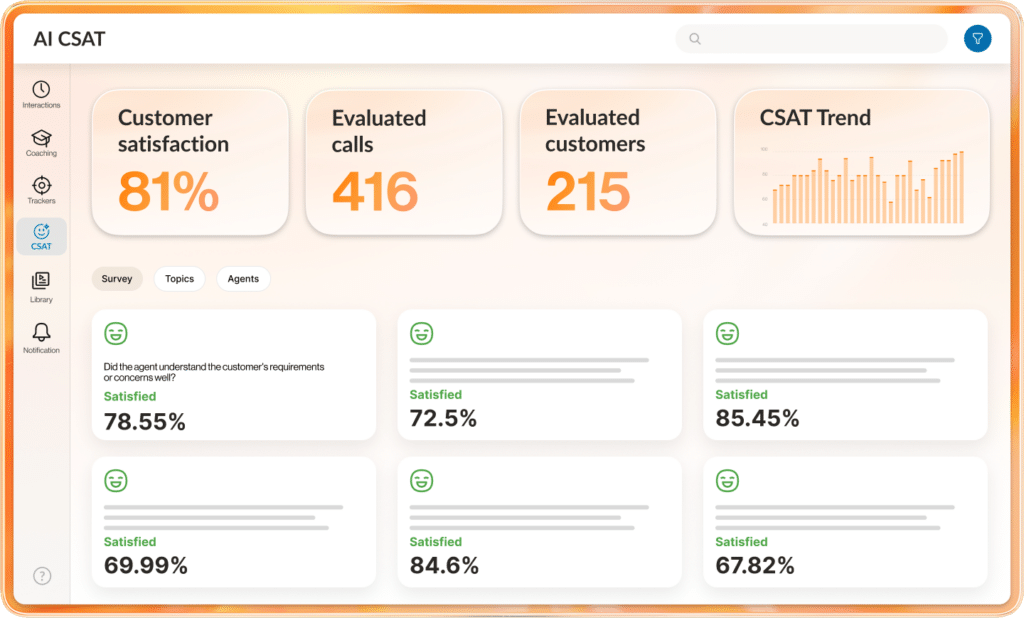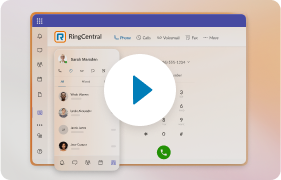Contact center supervisors reviewing weekly performance reports often encounter a challenge: the data they receive represents a fraction of the actual interactions their teams handled. Out of thousands of conversations, only a small percentage are followed by survey responses.
These limited data points are then used to assess service quality, guide coaching sessions, and inform broader business decisions. Most interactions go unevaluated, leaving teams to rely on limited feedback and surface-level metrics.
Agents, too, operate in this environment of partial insight. Many complete their shifts without knowing how their conversations were received unless a customer chooses to leave feedback.
With more interactions happening across more channels, tracking satisfaction has become more complex and more urgent. Customers expect fast, consistent support—and they notice when it falls short.
In this blog, we’ll explore how AI transforms the way customer satisfaction is tracked, and how RingCX helps contact centers capture feedback at scale—automatically, in real time, and across every channel.
Why traditional surveys provide limited, delayed insights
Surveys are still the default method for collecting CSAT, NPS, or Customer Effort Score. The approach is simple: after an interaction, customers are invited to rate their experience. Some stay on the line for a quick IVR survey. Others receive an email or SMS with a feedback link. This process, however, captures a small percentage of customers—usually between 5 and 15 percent.
The majority of customers do not complete surveys. Many are focused on resolving their issue and are ready to move on once the interaction ends. Some do not see the value in responding. Others may ignore follow-up messages entirely.
Another important consideration is the quality of data collected through manual surveys. Even when customers do respond, their input is often polarized—tending to come from those who had either a very negative or a very positive experience. This skew can distort overall insights.
Additionally, some respondents may not take the survey seriously and provide random or inconsistent answers. When this happens, the data gathered may not accurately reflect the broader customer base, leading to misinformed decisions if taken at face value.
With this, contact centers end up building reports, launching coaching efforts, and adjusting workflows based on feedback from a small and potentially unbalanced subset of customers.
Timing gaps make action difficult and reactive
When feedback is collected using traditional survey methods, it often arrives too late to be useful. A customer who expresses dissatisfaction in a survey submitted days after an interaction may have already disengaged with the brand. The opportunity to follow up or resolve the issue has passed. For agents and supervisors, this delay removes any chance of adjusting in the moment.
Supervisors trying to support their teams must wait for reports to be compiled and distributed. By the time a coaching conversation happens, the original interaction is no longer fresh. Agents may not recall the specifics of what happened. Feedback loses its effectiveness when it cannot be tied to recent behavior. The contact center becomes slower to respond, both to individual customer issues and to broader service trends.
How AI transforms customer satisfaction tracking from limited to comprehensive
Artificial intelligence changes how contact centers collect and analyze customer satisfaction. Instead of depending on the customer to provide feedback, AI measures sentiment directly from every conversation. It evaluates how language is used, how tone shifts, and how the interaction flows to identify likely satisfaction levels. Every call, message, or thread becomes a complete data point. No follow-up survey is needed.
This approach provides consistency, coverage, and timeliness that traditional surveys cannot match. Satisfaction is evaluated immediately after the interaction, based on full-context signals—not delayed, self-selected opinions. Supervisors and quality teams gain immediate visibility into how interactions are going across the board, including those that would otherwise be missed. With every customer accounted for and every channel included, AI provides a far more accurate, real-time view of customer sentiment.
Best practices for AI-driven CSAT tracking with RingCX in contact centers

RingCX offers an AI-native contact center platform built specifically to solve CSAT tracking challenges. It gives contact centers a complete, scalable, and automated way to monitor satisfaction across every interaction—without relying on manual surveys or limited reviews.
Below are the key capabilities RingCX delivers to support accurate and timely customer satisfaction tracking:
Use AI Interaction Analytics to evaluate 100% of customer conversations
AI Interaction Analytics evaluates every customer conversation to extract CSAT, NPS, and sentiment metrics—without requiring customers to fill out a survey. This eliminates sample bias and ensures supervisors see the full picture. Interactions are processed uniformly, giving a comprehensive view of satisfaction levels across teams, topics, and time periods.
The platform offers dashboards to visualize trends, compare agents, and drill into specific performance indicators. Leaders can take action based on complete data rather than anecdotal feedback. Instead of measuring how a few customers felt, teams can now measure how every customer responded.
Build consistency across performance reviews with AI Quality Management
With AI Quality Management, supervisors can assess 100 percent of customer interactions—eliminating the need to manually sample or search for representative calls. Scorecards are applied automatically using AI models trained to identify key service behaviors and satisfaction drivers.
RingCX includes omnichannel quality scoring, so calls, messages, emails, and chats are reviewed with the same logic and standards. With this full coverage, contact centers can tie satisfaction data directly to agent behaviors and build more accurate coaching programs.
Strengthen QA processes with calibrated scorecards and targeted playback
AI-assisted scorecard calibration ensures that evaluation criteria remain clear, relevant, and up to date. The system reviews existing scorecards and offers recommendations to remove ambiguous questions, define success criteria, and refine performance indicators. This helps improve the fairness and reliability of agent reviews.
Supervisors can also access Automated Scorecard Playback, which highlights the exact moment in a conversation tied to a score. This allows managers to provide specific, behavior-based feedback without combing through entire transcripts or recordings.
Get full CSAT visibility with RingCX
Customer satisfaction is too important to be measured by a small percentage of survey responses. Relying on limited data exposes contact centers to blind spots that slow down improvement and overlook key service moments.
With AI-powered tools like RingCX, tracking customer satisfaction becomes accurate, immediate, and fully integrated into every customer conversation.
RingCX gives supervisors, agents, and QA teams the tools to understand how every customer feels—without waiting for survey results or chasing feedback.
Stop relying on partial feedback. Let RingCX show you how AI delivers full visibility into customer satisfaction.
Originally published Jul 31, 2025












